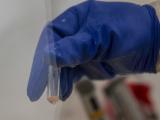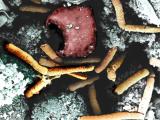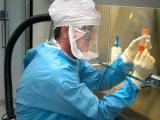Jul 8, 2004 (CIDRAP News) Scientists have developed a three-dimensional molecular image of how anthrax toxin breaks into human cells, which should help the effort to design drugs to shut the toxin out, according to the National Institute of Allergy and Infectious Diseases (NIAID).
The NIAID-sponsored research is described in a report published online Jul 4 in Nature, the agency said in a news release. The study was led by Robert C. Liddington, PhD, of the Burnham Institute in La Jolla, Calif.
The research also suggests a possible way to modify anthrax toxin so that it would selectively attack tumor cells, the NIAID said.
Anthrax uses a protein called protective antigen, one of three components of anthrax toxin, to enter human cells, the NIAID noted. Protective antigen can bind either of two different receptors on cell surfaces, CMG2 or TEM8. The investigators mapped the three-dimensional structure of protective antigen bound to CMG2, using an intense x-ray beam to determine the position of the atoms in a crystal form of the protein complex.
In previous studies, scientists had determined the three-dimensional structure of protective antigen and CMG2 in their separate states. "The structure of the protective antigen proteinCMG2 receptor complex offers a more precise, finely detailed snapshot of a crucial step in the intricate molecular choreography that ushers anthrax toxin into cells," the NIAID said.
"This detailed, 3-D image provides researchers clearer targets for shutting down this process. For researchers working on anthrax antitoxins, the new 3-D image is like having a roadmap that connects two cities rather than having only separate maps of the two cities."
NIAID Director Anthony S. Fauci commented, "This elegant work provides important new leads for the development of novel antitoxins to protect people from anthrax." He said antitoxins could save lives late in the course of the disease, when large amounts of toxin are present and antibiotics are less effective.
According to the NIAID statement, Liddington said the newly mapped structure points to a potential new tumor treatment using a genetically modified anthrax toxin. The TEM8 cell receptor is commonly found in cells lining the blood vessels of tumors. Its structure has not been determined, but scientists expect it to be similar to that of CMG2.
It may be possible to design a version of the anthrax toxin that binds to TEM8 but not to CMG2, Liddington said. Such a toxin would kill tumor cells while leaving ordinary cells unharmed.
Santelli E, Bankston LA, Leppla SH, et al. Crystal structure of a complex between anthrax toxin and its host cell receptor. Nature 2004 Jul 4 (advance online publication) [Abstract]
See also:
Jul 4 NIAID news release
















